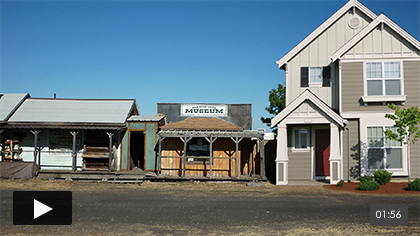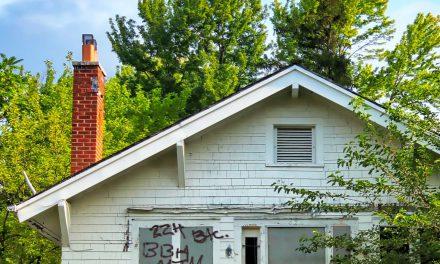Absentee homebuyers consist of 24% of the market, as of Q4 2015. This is down from the January 2013 peak, when they made up 32% of all homebuyers. Home sales volume also fell during Q4 2014, to 7% below the same period one year earlier.
Speculator activity drives home sales volume, which in turn drives pricing. Home prices peaked across most of the state in Q3 2014, then fell in some areas during Q4 while other areas saw prices continue to rise. Expect prices to trend downward throughout 2015 due to the lack of support from sales volume.
Chart update 02/26/15
| Q4 2014 | Q3 2014 | Q4 2013 | |
| Absentee homebuyer percentage | 23.6% | 23.6% | 27.2% |
| Home sales volume | 103,000 | 113,000 | 105,000 |
Pricing index | 222 | 220 | 204 |
Speculators drive — and crash — the market
The chart above displays three indicators of California’s housing market:
- the percentage of absentee homebuyers (mostly speculators) purchasing homes in Southern California (the red line);
- the number of homes sold monthly across California, expressed as a 6-month moving average (the gold line); and
- the Case-Shiller Home Price Index of low-tier home sales, which is an average of homes which sold for under $461,000 in Los Angeles, San Francisco and San Diego (the blue line).
The chart reveals this trend:
Speculator activity drives home sales volume, which then drives changes in pricing.
The percentage of absentee homebuyers peaked in January 2013 at 32.4% (even higher when trustee’s sales are included). Home sales volume peaked five months later at 44,000 homes sold in May 2013. One year later, and home prices are showing signs of leveling off quickly.
Likewise, absentee homebuyers most recently bottomed in May 2010 at 19.7%, right after the end of the single family residence (SFR) tax credit stimulus. Home sales volume followed on schedule, bottoming eight months later at just under 28,000 homes sold in January 2011. Pricing bottomed 14 months after sales volume, in March 2012.
It typically takes longer for sales volume and pricing to adjust in a declining market, due to the sticky price phenomenon. Sellers are hesitant to accept offers below expectations groomed by price movement in the recent past, which contributes to the longevity of high prices.
On the other hand, momentum causes homes to sell quickly and at higher prices during a rising market. Speculators abound during a market of quickly rising prices, contributing to the frenzy. Once speculators drop out, sales volume begins to slow, followed roughly 12 months later by a drop off in prices.
What causes speculators to quit the momentum market? It’s all about demand.
Once prices surge too high, demand from end users (owner-occupants and long-term buy-to-let investors) trickles off. Once speculators realize end users aren’t playing anymore and they’re essentially just trading homes with other investors, they choose to take their cash elsewhere.
Forecasting for reality
We’d all like a crystal ball to glimpse into the future of California’s housing market. Since that’s never going to happen, try using this chart.
Here at first tuesday, we’ve been saying it for months: you can’t count on speculators to fuel the market. History has shown counting on speculation to push us through a full housing recovery is like expecting to run a marathon on Skittles and M&Ms. (Sure, you might get off to a good start, but you’re not going to get past mile three without something more sustainable.)
What you can count on is a massive sugar crash. As speculators continue to flee the market in late-2014, sales volume continues to lose altitude.
Last to fall is pricing. Home prices are 14% above last year’s levels, as of the most recent July 2014 report. This percentage has fallen consistently over the past 12 months.
Expect price reports to show a dive in Q3 2014, 12-14 months after home sales volume began its descent.
Jobs for a sustainable recovery
The goods news is end users are almost ready to provide the support needed for a sustainable housing recovery.
It may be difficult to comprehend, but California is just now regaining the number of jobs lost during the 2008 recession. Expect a full recovery of all jobs lost by the end of 2014 (however, counting the population gain experienced between 2008 and today, the real jobs recovery won’t actually occur until around 2019).
Further, average incomes fell during the recession, returning in most regions by 2012. Considering the intervening consumer price inflation (CPI) of roughly 2% per year, the purchasing power of incomes has barely caught up with its 2007 peak.
The next three years are going to be touch and go for the housing market. Still, expect more and more end users to return to home buying, this time with the full support of jobs and rising incomes, along with a more cautious eye for the market.
And don’t forget: watch out for speculators along the way. When speculators begin to make up a significant portion of local real estate deals, you know you can count on a few good months of sales volume and pricing. But as soon as they leave, expect sales volume and prices to follow. Preparing your finances for a volatile sales environment is the key to success: no crystal ball required.















Buffalo, that might be true in Santa Barbara, but it does not mean the article is inaccurate for the other 38.2 million people that live in the state of California.
Don’t count the speculator-investor out!
Currently in Santa Barbara real estate landlord investors (speculators) are out bidding homeowners on most all of the low end of the market listings ( especially bank owned foreclosure listings ) and generally 6 of them bid more than the asking price and with all cash as is offers. Right now the demand by investors appears to be unlimited and insatiable. They (with literally unlimited money to invest in rental houses ) will surely drive the pricers up at least another 20% over the next year, and they are simply not going to go away. It can not be otherwise! In my opinion First Tuesday is just WRONG WRONG WRONG ON THIS ISSUE!
I am wondering if ‘speculator’ means non owner occupied buyer aka. investor. It seems the numbers have historically been about 20%, which its return should indicate a more normal market place.
While we have seen some speculation in various market places, it seems that prices will increase again when people feel more comfortable about their work situation (read economic prosperity here) then they will not care that investors are buying and will push the market more themselves, as we see in the bay area and probably LA as well.